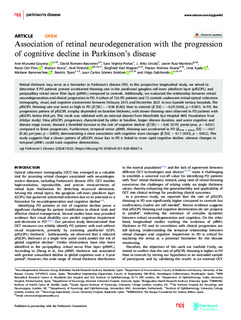Título
Association of retinal neurodegeneration with the progression of cognitive decline in Parkinson’s diseaseAutor-a (de otra institución)
Otras instituciones
Donostia Unibertsitate OspitaleaHospital Universitario de Araba
Hospital Universitario de Cruces
Ikerbasque
NIHR Moorfields Biomedical Research Centre
Universidad del País Vasco/Euskal Herriko Unibertsitatea (UPV/EHU)
University College London
Instituto de Investigación Sanitaria Biobizkaia
Instituto de Investigación Sanitaria Biobizkaia
Centro de Investigación Biomédica en Red de Enfermedades Neurodegenerativas (CIBERNED)
https://ror.org/05grdyy37
Versión
Version publicada
Derechos
© 2024 The AuthorsAcceso
Acceso abiertoVersión del editor
https://doi.org/10.1038/s41531-024-00637-xPublicado en
npj Parkinson's Disease Vol. 10. N. art. 26Editor
Springer NatureResumen
Retinal thickness may serve as a biomarker in Parkinson’s disease (PD). In this prospective longitudinal study, we aimed to determine if PD patients present accelerated thinning rate in the parafoveal ... [+]
Retinal thickness may serve as a biomarker in Parkinson’s disease (PD). In this prospective longitudinal study, we aimed to determine if PD patients present accelerated thinning rate in the parafoveal ganglion cell-inner plexiform layer (pfGCIPL) and peripapillary retinal nerve fiber layer (pRNFL) compared to controls. Additionally, we evaluated the relationship between retinal neurodegeneration and clinical progression in PD. A cohort of 156 PD patients and 72 controls underwent retinal optical coherence tomography, visual, and cognitive assessments between February 2015 and December 2021 in two Spanish tertiary hospitals. The pfGCIPL thinning rate was twice as high in PD (β [SE] = −0.58 [0.06]) than in controls (β [SE] = −0.29 [0.06], p < 0.001). In PD, the progression pattern of pfGCIPL atrophy depended on baseline thickness, with slower thinning rates observed in PD patients with pfGCIPL below 89.8 µm. This result was validated with an external dataset from Moorfields Eye Hospital NHS Foundation Trust (AlzEye study). Slow pfGCIPL progressors, characterized by older at baseline, longer disease duration, and worse cognitive and disease stage scores, showed a threefold increase in the rate of cognitive decline (β [SE] = −0.45 [0.19] points/year, p = 0.021) compared to faster progressors. Furthermore, temporal sector pRNFL thinning was accelerated in PD (βtime x group [SE] = −0.67 [0.26] μm/year, p = 0.009), demonstrating a close association with cognitive score changes (β [SE] = 0.11 [0.05], p = 0.052). This study suggests that a slower pattern of pfGCIPL tissue loss in PD is linked to more rapid cognitive decline, whereas changes in temporal pRNFL could track cognitive deterioration. [-]
Colecciones
- Artículos - Ingeniería [684]
El ítem tiene asociados los siguientes ficheros de licencia:























